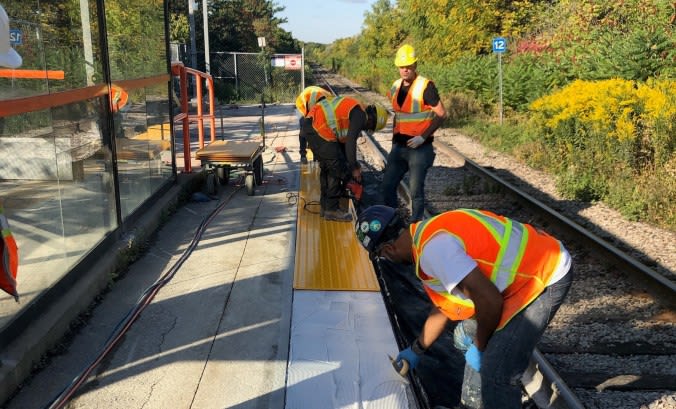Pulling the emergency brake after missing your stop is a no GO
How to get on and off GO trains seamlessly during construction – without sounding the alarm
Aug 16, 2021
GO Transit is reminding customers on the proper use of on-board emergency equipment after an increase in customer-caused train delays.
Pulling the emergency brake, door release, or yellow emergency strip can cause lengthy delays for everyone and Metrolinx officials are hoping to prevent future delays as construction ramps up at several GO stations.
Metrolinx is consistently improving stations to ensure the best possible service and experience for transit customers.
This includes work on train platforms. One of the most common reasons for platform construction is the installation of yellow tactile safety tiles that show people where to safely stand.
Construction crews installing yellow tactile strips on a GO station platform. (Metrolinx photo)
Sometimes this work requires temporarily closing portions of the platform. When this happens, only certain train doors can open at that station to prevent customers from being dropped off into an active construction site.
Currently there is platform work happening at Oakville GO Station. This means not all GO train doors will open at Oakville GO. This work is expected to continue with door restrictions in place until the Fall.
Metrolinx says there have been a few incidents recently where customers missed their stop because of the door restrictions.
- Earlier this month, customers did not move down the train to where the doors would open and missed their stop – instead of getting off at the next stop, pulled the emergency brake on-board – bringing the entire train to a stop.
- On August 16, customers were not in the correct train car to get off at Oakville GO and pulled the emergency door release and got off into a construction site.
Metrolinx says these incidents and others like it caused the entire train to be delayed by as much as 20 minutes as the crew needs to check for emergencies before the train can start moving again – it can also cause other train trips to be delayed if there’s congestion on the tracks.
Customers also risk getting a ticket, as pulling the emergency brake for a non-emergency, is against the law.
When to use onboard emergency tools
Every GO train is equipped with a few emergency tools to keep customer safe. This includes yellow emergency strips, an emergency door release, and an emergency brake for in the event of a serious a major problem.
The emergency brake and door release are intended for crew and first responder use only.
GO Transit staff know there are a number of reasons why customers might need to push the silent yellow emergency strip – but transit officials want to remind customers that missing your stop because your coach doors did not open is certainly not one of them.
These tools are reserved for life-threatening emergencies and crimes in progress.
How to stay informed
To keep GO customers in the know of these impacts, the transit agency is constantly updating the Construction Projects and Improvements webpages.
Infographic explaining how the door restrictions work for the Oakville GO platform construction. (Metrolinx image)
Customers can also find a handy list of stations under construction on the GO Transit service alerts webpage
Another key form of communication is onboard GO trains themselves.
Customer Service Ambassadors (CSAs) make announcements during the trip to advise which train door will not open at certain stations.
If you find yourself on a train and are unsure about which doors will open at your station, CSAs are in the accessibility coach (the middle train car) and can help you out.
Customers are also encouraged to sign up for On the GO alerts to get text messages or emails about delays, cancellations, new schedules, service improvements, construction and other important transit news.
On the GO alerts can be customized for specific trip information, such as train or bus routes, and preferred locations and travel times.
Metrolinx knows construction can be a pain, but delaying an entire train isn’t good for anyone.
by Frank Paul Metrolinx customer communications senior team leader
